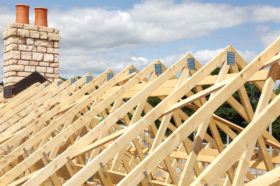
Early Bird Offer! Free tickets to meet independent experts at this summer's Build It Live
Save £24 - Book Now!
Early Bird Offer! Free tickets to meet independent experts at this summer's Build It Live
Save £24 - Book Now!A measure of thermal transmittance, U-values express the rate of heat transfer through any element of a building, such as a wall, roof or window. Because the construction of these elements can vary so much with design and the choice of materials available, the U-values can vary too – hence they need to be calculated specifically for each element.
In practice, the manufacturers of insulation (for instance) will give guides to the U-values achieved when their products are used in a variety of constructions and some have U-value calculators on their websites.
The units used to express U-values are watts per m² Kelvin (W/m²K). This means that if a wall, for example, had a U-value of 1.0 W/m²K, for every degree of temperature difference between the air on the surface inside the wall and the air on the surface outside, 1 watt of heat would pass through any m² of walling.
Most materials have known and published values for the rate at which heat is conducted through them under specified conditions. These values are known as k-values. They are a measure of thermal conductivity. In any element, such as a wall, the k-values for each material layer are divided into the thickness of that material to obtain the R-value for that layer or the thermal resistance. When they are added all together, the total resistance for the complete section of the wall is nearly found (the air resistances for the inner and outer face have also to be added on). The total resistance is then divided into one to obtain the reciprocal of resistance and this figure is the U-value for the wall.
Since materials may vary in their k-value – even though they look the same – selecting the wrong one may have a bad effect on the U-value. For example, a mistake frequently made on site is to choose an inner-leaf block for a cavity wall that may appear the same as the one specified, but in fact has a higher crushing strength and a worse (higher) k-value. The resultant U-value may mean that the wall has to be lined internally with more insulation beneath dry lining plasterboard to recover the U-value.
Part L (Requirement L1) of the Building Regulations covers ‘Conservation of Fuel and Power’ and U-value maximums have traditionally been set by these regulations. They still are in the case of extensions, but for new buildings a more holistic approach has to be taken to prove reasonable energy efficiency. Whole building calculations that assess the carbon emissions from a building have to be carried out now, and although U-values are included in these assessments, they form only a part. For new homes up to 450m² – SAP (Standard Assessment Procedure) programmes are used to perform these calculations and for anything bigger SBEM (Simplified Building Energy Model).
Because whole-building energy calculations can take account of many factors, U-values in some elements exceed the values shown in the list above and can be compensated for elsewhere in the design. But not to an unreasonable extent – there are limits set out in the Building Regulations. The limiting U-values are shown below and should never be exceeded:
These restricting parameters exist to ensure that some future-proofing is built into the home, and that you haven’t completely designed out insulation by using sustainable sources like solar panels or wind-turbines to generate your own fuel and power, only to discover that future owners replace them with mains gas.
Remember, the higher the figure, the worse the thermal insulation quality. If you want a comfortable, modern home that has relatively small heating requirements, aim to keep your U-values low (and ideally less than the figures below):
Main image: This hybrid SIPs wall element by Hanse Haus delivered U-values of just 0.09W/m2K on a Passivhaus project


Comments are closed.